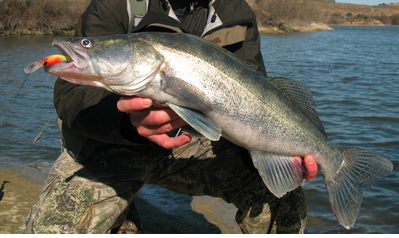When walleyes run deep in lakes, reservoirs and rivers, there are several ways to reach them, such as jigging, deep trolling and, the best advisable method, bottom-bouncing. The bottom-bouncing rig consists of a lead weight fixed to a piece of wire, used to feel the bottom of a river or lake but avoid snags. The wire is formed in a reverse ‘V’. The lead is attached to one leg and on the other is a swivel and clip where the leader and hook is tied. The main line is tied to the bend to pull both ends. By this method the bait is kept just a little off the bottom, right in the noggins of the deep-lying fish.  The main consideration in using bottom-bouncers is weight: how much, when, where. The answer is, use just enough weight to allow the rig to trail at a 45-degree angle behind the boat. Too light and there will be too much trailing line, allowing the rig to ‘float’ up at the slightest increase in speed; too heavy and the rig will scour the bottom, scaring the fish away. With the correct weight, the wire will barely touch bottom, clicking when it does, attracting the attention of the fish.
The main consideration in using bottom-bouncers is weight: how much, when, where. The answer is, use just enough weight to allow the rig to trail at a 45-degree angle behind the boat. Too light and there will be too much trailing line, allowing the rig to ‘float’ up at the slightest increase in speed; too heavy and the rig will scour the bottom, scaring the fish away. With the correct weight, the wire will barely touch bottom, clicking when it does, attracting the attention of the fish.
To find that ideal combination, use your desired weight and bait arrangement along with a spinner. Start the trolling motor to get the boat running. Dangle the rig over the side and slowly increase speed until the spinner blade starts turning. (Remove the spinner if you wish, but it is there to attract the fish.) Pay out line until the rig hits bottom, then raise it about six inches. That is the way you go. Keep watch on your electronics to see if you are going through sloughs or elevations, and lift or lower the rig accordingly. The idea is to keep it near bottom always without, however, snagging on bottom structure.
The recommended ensemble is a 6 ½ -foot baitcasting rod paired with a reel equipped with a flipping switch that will allow you to pay out more line instantly by simply clicking the switch. An abrasion-resistant 10-lb. mono will handle most bites and fights, but if the bottom has numerous snags, you may want to use lines up to 20 lbs. weight. The trick is to feel the bottom instantly so you can raise the rig out of harm’s way fast. You can troll several rigs this way, in addition to no-bouncer rigs that run middepth for suspended walleyes.
In clear water with few snags, your leader may be as long as four to five feet; but in areas where sunken snags like wood or weeds abound, shorten it to about 1.5 feet for better control.
Altogether, the bottom bouncer is a very effective way to keep your bait near the bottom where the fish are, mostly during the cold season. With side-scanning sonar you can even keep watch over it to know when a fish has taken the bait. You can also make a slip-bob rig that allows you pay out line when fish are leery of unexplained weights, or a bottom-bouncer with spinners to attract the fish much like fishing for salmon.
Whatever, with a little ingenuity and the bottom-bouncer, you can reach the fish no matter how deep they are, and entice them to bite. After all, that is the essence of the sport, isn’t it?
Bottom-bounce for Walleyes
Published June 24, 2010 | Freshwater Knowledge

No comments yet. Be the first to comment!